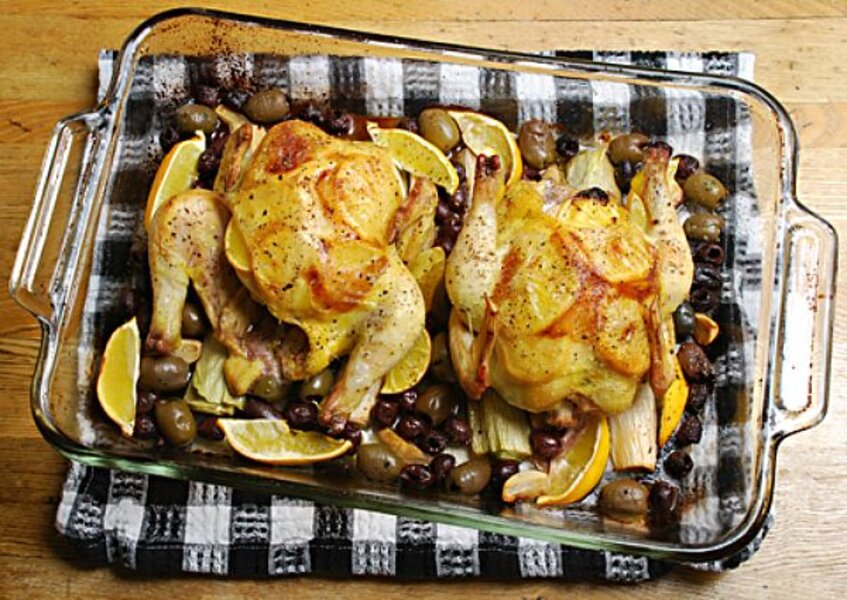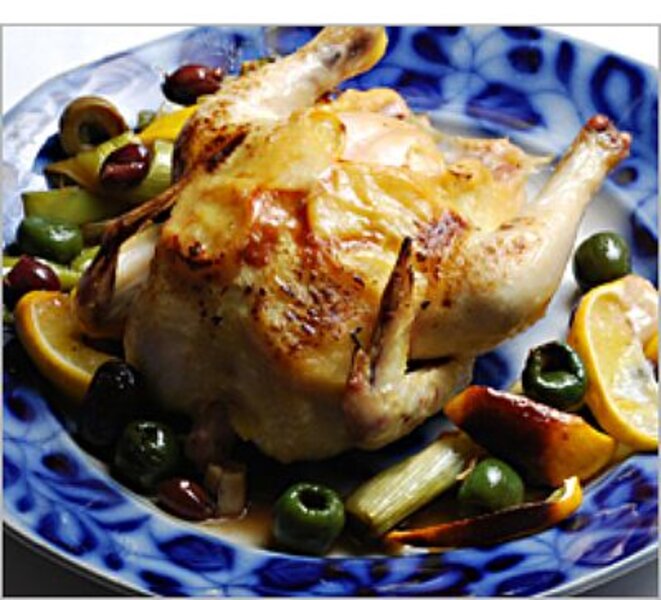For Valentine’s Day, a pair of birds you’ll love
Loading...
Marion cooked for me on our first date. I cooked for her on our second date (which was the next night – was I moving too fast?). We only learned much later that cooking for someone this early in a relationship (is it even a relationship on the second date?) can be pitted with minefields. Somehow we survived. Thousands of home cooked meals later, when we want a romantic dinner, home cooking often wins out over restaurants. For this Valentine’s Day dinner, I’m turning the kitchen over to Marion.
When you are thinking about a romantic dinner, presentation is as important as taste. You want to create something that is delicious, but that also honors the beauty of the occasion. And it helps to have something that is easy to assemble, and that you can put together beforehand – no sense fussing around in the kitchen when you could be enjoying time with your guest.
That’s the great thing about Cornish hens. There is something elegant about having an entire little bird on your plate. And when the recipe is this one, with the hens prepped way in advance and then slipped into the oven to roast to a golden brown, and your home slowly filling with a wonderful aroma, and the thin lemon slices barely visible through the translucent skin, well, the effect can be more than a little decadent.
The inspiration for this dish was sweet, fragrant Meyer lemons, which seem to be everywhere this winter. They are suddenly so ubiquitous that this weekend we found them at a neighborhood grocery store, six in a bag for $2.50, a record low for the Midwest. They are so beautiful, with their thin skins and their lovely scent, that I don’t know how anyone can resist them.
This recipe is easy to assemble – a lot of the work may be done early in the day. You can prepare the bed of vegetables and the hens hours beforehand, then hold them over in the refrigerator until an hour before you intend to start roasting them. After you slide them into the oven, serve a simple starter, just some cheese or toasted hazelnuts. Start this dinner with a green salad, if you like, and serve the hens with a little rice on the side.
If you don’t like olives, you’ll still like this dish. You don’t have to eat the olives, in fact, to enjoy their presence. They meld with the garlic and lemon to impart a beautiful flavor to the hens, without punching you with total olive flavor.
(See next page for recipe)
Cornish Hens with Meyer Lemons and Olives
Serves 2
2 Cornish hens
3 Meyer lemons
8 small garlic cloves or 4 large ones
3 small leeks
1-1/2 cup olives [see Kitchen Notes}
Salt
Black pepper
Olive oil
Take the hens out of the refrigerator about an hour before you intend to roast them so they can come to room temperature.
Slice one of the lemons very thinly. Cut the other two into eight wedges each. Peel the garlic cloves. If they are large, cut them in half lengthwise. Clean and prepare the leeks. Slice off root end and most of the green tops. Slice leeks in half lengthwise. Rinse under running water, fanning layers to wash out any trapped grit. If the olives are standing in their brine, drain them.
Coat a roasting pan (not a deep one – I used the shallow glass baking dish you see in the photo) with olive oil. Place the leeks in the pan, cut side down and spaced evenly; then pour in the olives so they are evenly spaced around the dish. Scatter the lemon wedges and garlic cloves around everything. The idea is to create a bed on which you will roast the hens.
Loosen the breast skin on each of the hens. Slip lemon wedges under the skin so the breast is completely covered with slices. If you have any left, put them in the hen’s cavity. The same goes for any tag ends of the lemon.
If you are doing advance prep, at this point, cover the hens and put them back in the refrigerator, cover the baking pan and put it in the fridge too. Take them both out an hour before you want to start roasting, so everything can come up to room temperature.
When you are ready to start the hens, preheat the oven to 425 degrees F. Arrange the hens on the bed of olives, lemon, leeks and garlic. Paint them well with olive oil, give everything a good grinding of black pepper, then salt the hens lightly.
Put the pan in the hot oven and set a timer for 20 minutes. At 20 minutes, lower the heat to 350 degrees F. and set the timer for another 25 minutes. At that point, check the hens. They should be golden brown and the little legs should move easily. Check the temperature with an instant read thermometer in the thickest part of the breast (I know – trying to find a thickest part on these tiny things is not so easy). The hens are ready when they reach 165 degrees F.
At that point, take the pan out of the oven. Let it sit for five minutes. For the presentation, place a hen in the center of the plate, arrange a couple of leeks to one side, and a little mound of rice, if you are serving it, on another side. Simple, elegant, delicious.
Kitchen Notes
What makes them Cornish? Their names, not their origins.These little all-white-meat chickens were first bred in Connecticut in the 1950s.
Why are you telling me to use garlic on date night? You won’t smell all horribly garlicky from this – the big chunks and slow cooking just add to the mellow deliciousness.
What kind of olives? Good cured ones. Make sure the olives are pitted. We used a mix of tiny niçoise and bigger brine-cured green olives, like Nafplions, lucques or picholines. As for those pallid things that come in cans, don’t use those. They don’t taste like much of anything, and they were probably “cured” with lye. They do have diverting names, though. Super Mammoth is the largest, but Extra Jumbo is, well, medium, but smaller than Giant, yet way larger than Superior. I may not love canned olives, but I love their names.
Terry Boyd, and occasionally his wife, Marion, blog at Blue Kitchen.
To leave comments on the original site, click here.
--------------------------------------------------------------
The Christian Science Monitor has assembled a diverse group of food bloggers. Our guest bloggers are not employed or directed by The Monitor and the views expressed are the bloggers' own and they are responsible for the content of their blogs and their recipes. All readers are free to make ingredient substitutions to satisfy their dietary preferences, including not using wine (or substituting cooking wine) when a recipe calls for it. To contact us about a blogger, click here.






